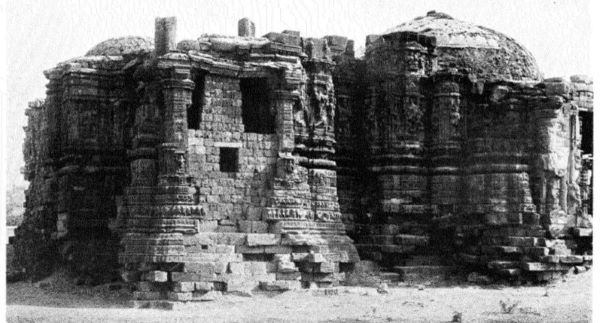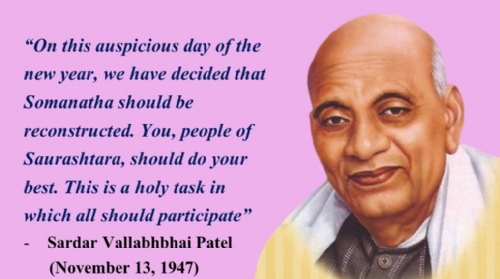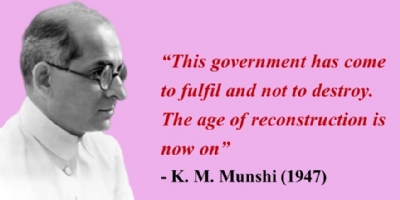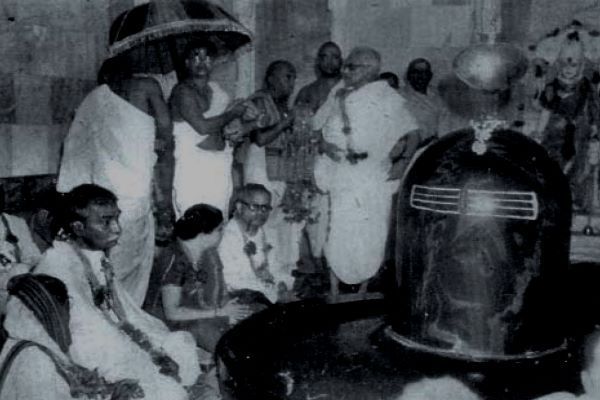Somnath Temple: A mesmerising story of India's power of reconstruction over power of destruction
Total Views |
- Harshad Tulpule
“The reconstruction of the Somnath Temple will be complete on that day when not only a magnificent edifice will arise on this foundation, but the mansion of India's prosperity will be really that prosperity of which the ancient temple of Somnath was a symbol. The Somnath temple signifies that the power of reconstruction is always greater than the power of destruction.” These are the words of India’s first President Dr. Rajendra Prasad when he performed the installation ceremony for the Somnath temple in 1951.

The words proved to be true even after around 70 years when Ayodhya verdict came out. It was indeed a victory of nation! Ayodhya case is now well-known to all Inidans including the younger generation as it’s a recent phenomenon. However, India has a long history of destruction and reconstruction of temples. A prominent example which proves India’s superiority of the power of reconstruction over the power of destruction, is Somnath temple at Prabhasa.
The history of Somnath Mandir in Prabhasa resembles Ram Mandir in Ayodhya. Both are among the most sacred temples in India. Both have ancient history, and both have been the victims of Mughal invasion. Despite facing several attacks, Somnath Mandir is illuminating India’s spiritual glory today. The historical story of Somnath temple reminds us of our own strength of standing firm against the attacks.
 Veteran national leader Kanhaiyalal Maneklal Munshi (K. M. Munshi) was the main driving force behind the reconstruction of the historically important Somnath Temple by the Government of India just after independence. In his classic book named ‘Somanatha: The Shrine Eternal’, he has elaborated the complete history of the temple with all available references.
Veteran national leader Kanhaiyalal Maneklal Munshi (K. M. Munshi) was the main driving force behind the reconstruction of the historically important Somnath Temple by the Government of India just after independence. In his classic book named ‘Somanatha: The Shrine Eternal’, he has elaborated the complete history of the temple with all available references. It was due to Munshiji’s indefatigable efforts that this shrine rose up again like the Phoenix. Hence this book has been written straight from the heart with all emotions and passion. “With the dawn of a new era, the new temple has risen like the phoenix, from its own ashes,” said K. M. Munshi about this temple at the time of its renovation.
Ancient spiritual glory before Mughal invasion:
We all know that Somnath is the first among the 12 Jyotirlinga shrines of Lord Shiva. Mythological belief is that the temple was created by the Moon itself. Known evidence confirm its origin somewhere in prehistoric period. Somnath temple was an integral part of Indus valley civilization. Lord Shiva was worshipped five thousand years ago in the Indus Valley in the form of Pashupati. The Somnath temple is likely to have been constructed three times before Mughal attacks. It may have been constructed for the third time by around 8th century A.D.
Findings in Archaeological Survey reveal the ancientness of the temple. Archeologists found carved stone pieces, bricks, idols of various gods in the excavations made near the temple. There was also found a stone slab with Brahmi script of the Vallabhi period dating back to the 6th and 7th century. In spite of the passage of eight centuries, the foundation has not sunk at any place. Traces of this great temple left after centuries of vandalism testify to its ancient grandeur.

Series of destruction and reconstruction started:
The first Mughal calamity came in A.D. 1025 when Mahmud of Gazni invdaded Saurashtra and destroyed the temple of Somnath. King Bhoj was the ruler at that time. The temple was reconstructed somewhere around A. D. 1050. An inscription mentions Siyaka II coming to Prabhasa and performing a Swarna Tula ceremony in A.D. 1045.
The fifth reconstruction of the temple was done in around A.D. 1150 under the rule of Kumarapala, the then emperor of Gurjaradesha. It was not a mere reconstruction of the temple but of the whole town. It was extended by adding a strong fort-wall to the north and south of the temple. Bhava Brihaspati placed gold pinnacles on the temple. A court room for kings, a reservoir for pure water and buildings for priests to live in were constructed along with the temple. In 1297, Alaf Khan, a general of the Khilji rulers of Delhi marched to Kathiyawar and destroyed the ancient fame of the temple. The reconstruction was undertaken by the Chudasama ruler, Mahipaldeva.
 Alla-Ud-din Khilji, one of the most brutal and unscrupulous rulers known to history, attacked the temple in the 14th century. The damaged temple was restored by Mahipala, the Chudasam King of Junagadh. In the late 14th century. Zaffarkhan, the then governor of Gujarat built a mosque in Somnath and tried to convert the people to Islam but the people revolted and threw off the yoke of the Sultan and became independent.
Alla-Ud-din Khilji, one of the most brutal and unscrupulous rulers known to history, attacked the temple in the 14th century. The damaged temple was restored by Mahipala, the Chudasam King of Junagadh. In the late 14th century. Zaffarkhan, the then governor of Gujarat built a mosque in Somnath and tried to convert the people to Islam but the people revolted and threw off the yoke of the Sultan and became independent.The next major invasion was in 1394 by Muzaffar Khan who once more destroyed the temple. Despite invasions, the temple continued to remain as the sacred shrine of the Hindus till 1669 when Aurangazeb ordered its demolition.
In 1573, Akbar marched on Gujarat and annexed it to its empire. In 1701, Aurangzeb ordered to destroy Somnath temple ‘beyond possibility of repairs’. The temple was destroyed by him in 1706. Around the same period, Dhanaji Jadhav, a Maratha Sardar gave a tough fight to Aurangzeb and invaded into Saurashtra. Amhedabad was taken by Marathas in 1753.
In 1783, Queen Ahalya Bai of indore built a new temple at a little distance from the old temple. To save it from destruction, the Linga was placed in a secret under-grouund shrine immediately below the usual upper one.
In the 19th century, British imposed many restrictions on pilgrimage in Saurashtra in favor of Nawabs of Junagadh. The Nawabs wanted to destroy the importance of Prabhasa as a Hindu pilgrimage. However, The Junaagadh Sansthan was officially freed on September 15, 1947 from the hands of Nawab. Junagadh comprises 82% Hindus.
Unanimous decision of reconstruction after independence:
 The decision to construct a new glorious temple was unanimously taken after independence. The Iron man of India, Sardar Vallabhbhai Patel was instrumental in the process. Gandhiji was of the view that the temple should be built from public funding and not from government’s funding. The then ruling prince of Jamnagar Jam Sahib immediately gave the first donation of one lakh rupees for the reconstruction followed by Samaldas Gandhi Rs. 51000. By the end of 1949, about Rs. 25 lakhs were collected. The new temple was completed by stages at a total expense of 24,92,000. Renowned temple architect Prabhaschandar designed it and the first President of India Dr. Rajendra Prasad installed the Jyotirling in the new temple on May 11, 1951.
The decision to construct a new glorious temple was unanimously taken after independence. The Iron man of India, Sardar Vallabhbhai Patel was instrumental in the process. Gandhiji was of the view that the temple should be built from public funding and not from government’s funding. The then ruling prince of Jamnagar Jam Sahib immediately gave the first donation of one lakh rupees for the reconstruction followed by Samaldas Gandhi Rs. 51000. By the end of 1949, about Rs. 25 lakhs were collected. The new temple was completed by stages at a total expense of 24,92,000. Renowned temple architect Prabhaschandar designed it and the first President of India Dr. Rajendra Prasad installed the Jyotirling in the new temple on May 11, 1951.
K. M. Munshi also proposed to establish national Sanskrit University in Prabhasa which was approved by Sardar Vallabhbhai Patel. When the reconstruction of Somnath Temple was under discussion, a person, more fond of dead stones than live values pressed the point of view that the ruins of the old temple should be maintained as an ancient monument. But K. M. Munshi strongly put forward that the temple lived in the sentiment of the whole nation and its reconstruction was a national pledge. Its preservation should not be a matter of historical curiosity.
Why geographical location matters?
A question is often asked, ‘why Ram Mandir must be built in Ayodhya only? Why Somnath Mandir must be built in Prabhasa only?
The question doesn’t make any sense as the entire thousand years’ history of the temple, its spiritual background is attached to a particular place. The site of Somnath has been a pilgrimage site from ancient times on account of being a Triveni Sangam (the confluence of three rivers: Kapila, Hiran and Sarasvati) Prabhasa, where the Somnath temple is located, had been considered as a sacred place since the times of Mahabharata. Prabhasa was the most sacred place in the days of Bharata war. Suarashtra was believed to be an adopted village of Shri Krishna. Prabhasa, Dwrarka and Raivataka were near each other.
Prabhasa, in ancient times, was a centre of international contacts. It has a strategic location on the western coast of India.
The worship of Shiva is the basic layer of religious belief in India. Prabhasa was the centre of the great Shaivayogis. Soma is found completely associated with Shiva. According to Skanda Purana, visiting Prabhasa on a moonless night falling on Monday and bathing where Saraswati river meets the sea, was considered as a thing which gives highest religious merit. Prabhasa was associated with Shiva-worshiping Nagas who emerged as a confederacy of powerful tribes. Lord Shiva was once upon a time identified with the God of Fire in Prabhasa. This belief was clearly indicative of some geographical action.

The original temple of Somnath was the all-India centre of the Pashupata cult during historical times. Long before the second century A.D., the head of the Pashupata cult had his headquarters at Prabhasa. Somnath, as the principal shrine of Shiva can therefore be taken to have been established at least by the beginning of the Christian era to which period perhaps the First Temple belongs. Under the rule of Pratiharas, Prabhasa became a holy city as imortant as Kashi. The Chalukya branch of Saurashtra ruled from A.D. 750 to 950. Prabhasa was a great port and Somnath naturally was their guardian deity.
As the Somnath temple can’t be separated from the location of Prabhasa, We can’t think of Ram Mandir by detaching it from Ayodhya. Now the verdict is out which is worth welcoming. When the Ram Mandir will be actually built, It will once again prove the words of Dr. Rajendra Prasad – “Power of reconstruction is always greater than the power of destruction!”
Read
Somanatha, The Shrine Eternal, Munshi by NewsBharati on Scribd
